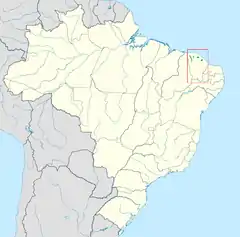Caatinga moist-forest enclaves
The Caatinga enclaves moist forests is an ecoregion of the Tropical moist forests Biome, and the South American Atlantic Forest biome. It is located in northeastern Brazil.
| Caatinga enclaves moist forests | |
|---|---|
 | |
 Caatinga enclaves moist forests ecoregion as defined by WWF. | |
| Ecology | |
| Biome | Atlantic Forest |
| Borders | Caatinga |
| Mammal species | 124[1] |
| Geography | |
| Area | 4,800 km2 (1,900 sq mi) |
| Country | |
| State | Ceará |
| Conservation | |
| Habitat loss | 14.9%[1] |
| Protected | 6.59%[1] |
The ecoregion forms a series of discontinuous, island-like enclaves amongst the much larger and dry Caatinga xeric shrubland and thorn forests ecoregion and Cerrado subtropical savannas ecoregion.
Setting
The Caatinga enclaves moist forests cover an area of 4,800 km2 (1,900 sq mi) in the state of Ceará, in northeastern Brazil. The enclaves are found mostly on four major regional plateaus, the Chapada do Araripe, Serra de Ibiapaba, Serra de Baturité, and Serra da Borborema. The enclaves are found on windward slopes and plateaus between 600 and 800 m (2,000 and 2,600 ft) elevation.
Flora
The main vegetation type is semi-deciduous forests with four strata of vegetation and emergent trees taller than 30 m (98 ft). The forest is generally similar in composition to the primary Atlantic Forests further east, but includes species from the Caatinga, Cerrado, and Amazon Rainforest as well.
The emergent and canopy layers are made up mostly of tree species of the families Fabaceae (Peltophorum dubium), Meliaceae (Cedrela fissilis) and Apocynaceae (Aspidosperma parvifolium).
Fauna
Fauna associated with this habitat shows a strong connection with both the Amazon Rainforest and the Atlantic Forest, and, to a lesser degree, the Caatinga.
Animals associated with this habitat include birds such as the grey-breasted parakeet (Pyrrhura griseipectus), ochraceous piculet (Picumnus limae), Ceará gnateater (Conopophaga lineata cearae) and Araripe manakin (Antilophia bokermanni), frogs such as Adelophryne baturitensis and A. maranguapensis, and lizards such as Mabuya arajara and Leposoma baturitensis.
In contrast to other groups, only a single species of mammal is endemic to these moist forests enclaves, the recently described Cariri climbing mouse (Rhipidomys cariri).[2]
Conservation
Most birds endemic to these moist forests enclaves are considered threatened, primarily due to habitat loss, by BirdLife International and, consequently, IUCN. In general the status of other animals is comparably poorly known, but likely to be similar to that of the birds.
See also
References
- Hoekstra, J. M.; Molnar, J. L.; Jennings, M.; Revenga, C.; Spalding, M. D.; Boucher, T. M.; Robertson, J. C.; Heibel, T. J.; Ellison, K. (2010). Molnar, J. L. (ed.). The Atlas of Global Conservation: Changes, Challenges, and Opportunities to Make a Difference. University of California Press. ISBN 978-0-520-26256-0.
- Tribe, C. J. (2005). A new species of Rhipidomys (Rodentia, Muroidea) from north-eastern Brazil. Arquivos do Museu Nacional, Rio de Janeiro, 63(1): 131-146
External links
- "Caatinga enclaves moist forests". Terrestrial Ecoregions. World Wildlife Fund.
